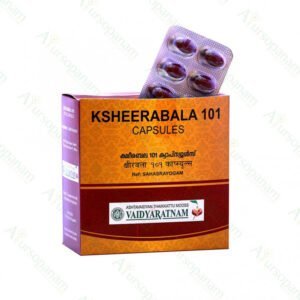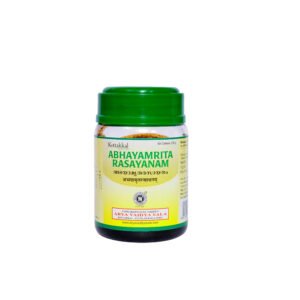Ayurvedic materia medica lists groups of drugs based on their ‘rasa’ or taste. Drugs dominant in ‘Tikta rasa’ or bitter taste act upon deranged Pitta and ‘digest’ it. This maybe understood as the resolution of inflammatory changes in the gut as well as skin, bones, joints and supporting tissue. Tiktaka Ghrita is a balancing combination of ‘Pitta-Samana’ drugs in a nourishing ghee base.
‘Ghrita’ or medicated ghee harnesses the healing properties of herbs and roots in a nourishing fat base. Ayurveda attributes ‘Sookshma’ property to ghrita, i.e. It is capable of reaching deep into tissues, and heals from within. It is perfectly suitable for long-term use in sustaining the effects of treatment in a body and preventing relapse.
Features & Benefits
- Balancing blend of Tikta rasa (bitter taste) and Seeta Veerya (cooling nature) drugs that pacifies deranged ‘Pitta dosha’ in the system.
- Deranged Pitta dosha vitiates ‘Rakta’ (blood), heats up the body, interrupts metabolic pathways and causes up build-up of endotoxins (ama), which manifests as chronic skin diseases and inflammatory changes in the gut.
- The Tiktaka combination pacifies the excess heat and acidity caused by this deranged Pitta in the gut and bowel. It relieves sour belching, acid eructation and indigestion.
- Tiktaka Ghrita improves skin health and immunity. It heals chronic lesions, with or without discharge, rashes and urticaria.
- Lifestyle diseases are invariably rooted in inflammation throughout the system. Tiktaka Ghrita breaks down inflammatory pathways and restores metabolism.
Dosage and Instructions
Adult: 10-15 ml of Tiktaka Ghrita, early morning on empty stomach, or at bedtime, followed by half a glass of lukewarm water, as recommended by the Physician.
Child: 5-7 ml of Tiktaka Ghrita, early morning on empty stomach, or at bedtime, followed by half a glass of lukewarm water, as recommended by the Physician.
Key Ingredients
Patola (Trichosanthes cucumerina)
Commonly known as Snake gourd, its fruit, leaf, and roots are used for medicinal purposes. with its properties including antidiabetic, hepatoprotective, cytotoxic, anti-inflammatory, larvicidal effects, Patola is used for treating headache, alopecia, fever, abdominal tumors, bilious, boils, acute colic diarrhea, haematuria, and skin allergy.
Nimba (Azardirachta indica)
It is commonly known as neem tree. Neem is used for various skin diseases, eye disorders, ulcers, gum diseases, for birth control. It is also used as a mosquito repellent. Neem leaf paste is used as a home remedy for skin rashes.
Katuka (Picrorhiza kurroa)
Also known as Katuki, it grows in the Himalayan regions and mainly root and rhizome of the plant are used for medicinal purposes. Used for liver problems, fever, allergy, etc.
Darvi (Berberis aristata)
It is commonly known as Indian barberry or tree turmeric. It is used to cure eye, ear, and throat-related disorders, Anti-malarial, Urinary troubles, Anti-bacterial, Anti-fungal, Anti-viral, treat burns and wounds, diarrhea, jaundice. It is also used for the quick healing of wounds and the paste of this herb is also useful in syphilis, ulcers, and anal fistula. Daruharidra helps to cure spasmodic pain and is very beneficial for patients with menorrhagia and leucorrhoea.
Pata (Cyclea peltata)
It is commonly known as Indian moonseed. It helps in enhancing immunity and preventing inflammation of the respiratory passages due to its immunomodulatory and anti-inflammatory properties. It is used in conditions including infertility, wound, hypertension, and skin diseases.
Duralabha (Tragia involucrata)
It is commonly known as Indian stinging nettle. Involucrata leaf has been traditionally used to treat inflammation, wounds, eczema, scabies, and skin infections. It has also been found to be effective in treating pain and bronchitis. The involucrata root has been traditionally used for the treatment of high fever.
Parata (Oldenlandia corymbosa)
It is commonly known as the diamond flower, it is an important drug used in fever in Ayurvedic preparations. It activates blood circulation, promotes diuresis, and relieves urinary problems, appendicitis, hepatitis, pneumonia, urinary infection, cellulitis, and snakebite.
Trayamana (Gentiana kurroo)
Mainly root is used for medicinal purposes. It is used to treat fever and is considered as a blood purifier and carminative. Kurroo is used in stomachache and urinary infections. The root with ginger root powder is also used for curing high fevers. The decoction of the root of Gentiana kurroo is useful to treat leucoderma and syphilis.
Musta (Cyperus rotundus)
Commonly known as common nutsedge. It is effective in gastritis, irritable bowel syndrome. Due to its breast purification property, it is used during postpartum care to avoid indigestion to the child. The paste is applied over the breast and washed after some time.
Bhunimba (Andrographis paniculata)
It is commonly known as Kalamegha. with its antibacterial and hepatoprotective properties, effective in jaundice and liver-related diseases. Also used for the treatment of snakebite, bug bite, diabetes, dysentery, fever, and malaria. It has antioxidant, antimicrobial, and anti-inflammatory properties. It also has a blood purifying activity. Together, Kalmegh might be useful in managing skin eruptions, boils, and scabies.
Chandana (Santalum album)
Commonly known as Indian sandal tree and well known for its aroma, it is considered sacred in some religions. It is used externally for skin-related and pyretic conditions. Also use internally in conditions like gastric problems, fever, chronic cough. It’s having a cooling effect.





















































Ratings & Customer Reviews
Reviews
There are no reviews yet.